Text Sarah Ahmed
Is there any better litmus test of what’s delicious and great value than what members of the wine trade themselves buy? Stocking up at Lisbon airport, the group of London-based sommeliers whom I lead on a tour of southern Portugal splashed their cash on Moscatel de Setúbal. I really hope that their enthusiasm translates onto their wine lists back home. While Port sells itself, this fortified Moscatel could do with more fine wining and dining ambassadors to sing its much deserved praises.
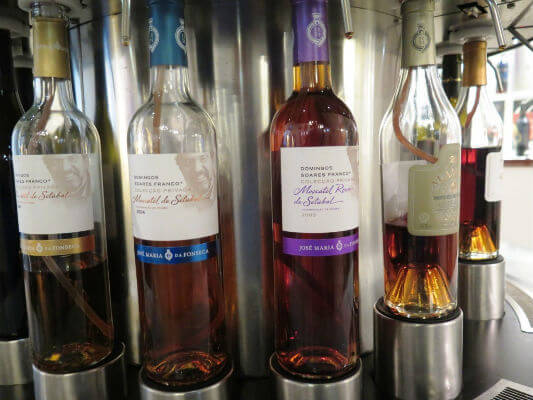
Take your pick of Moscatel de Setúbal at José Maria da Fonseca’s popular cellar door – Photo by Sarah Ahmed | All Rights Reserved
At Decanter World Wine Awards, my panel is similarly enamoured of its charms – there’s no better way to finish a day’s judging than to linger over a moreish flight of Moscatel de Setúbal. As the gold medals we regularly award them attest (not to mention their regular spot in the limelight at the Muscat du Monde awards), they are pure gold in every sense of the word. And royalty knew it. Apparently Moscatel de Setúbal was the toast of the courts of Richard II of England and Louis XIV of France. I suspect it was rather less good value in those days, so aren’t we the lucky ones – today you can drink like a king and pay like a pauper!
You’ll find my pick of those wines I tasted on last month’s visit to Setúbal Peninsula below. First, it’s worth taking a moment to explore what makes Moscatel de Setúbal so special. The natural place to start is the raw material – the Moscatel de Setúbal grape (a.k.a. Muscat of Alexandria), which must comprise at least 67% of the wine (85% for Moscatel Roxo). Though it’s generally considered to be inferior to its more famous parent, Muscat à Petits Grains, Setúbal producers cleverly extract the maximum aroma and flavour from Moscatel de Setúbal by macerating the fermented, fortified wine on skins for up to six months. What better way to release its heady perfume of mint, floral, citrus peel and ginger; peach tea in the case of the rare pink tinted Moscatel Roxo grape.
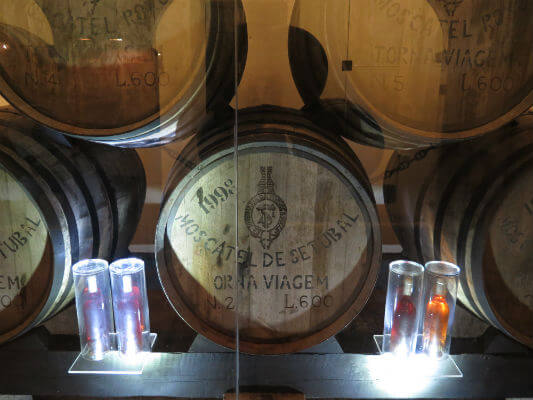
A return to Torna-Viagem at José Maria da Fonseca – Photo by Sarah Ahmed | All Rights Reserved
As for sheer deliciousness, top wines are barrel-aged to allow grape sugars to caramelise, also to concentrate the resulting nectars by evaporation. In the past, barrels were lashed to the deck of tall ships and despatched across the equator for optimum mouthfeel and character. António Soares Franco, CEO of José Maria da Fonseca, told us that, as a result of sea spray, the motion of the waves and widely fluctuating temperatures on deck, these so-called “Torna-Viagem” Moscatels are particularly balanced, soft and a little salty. I had the great good fortune to taste a 19th century example a few years ago and, though I recall no saltiness, I can vividly recall its remarkable balance and silky, mellow mouthfeel. It seemed remarkably young for all its adventures at sea!
Thrillingly, since 2000, José Maria da Fonseca have been trialling the Torna-Viagem technique with the Portuguese Navy and, as you can see, those barrels which have been at sea appear to have aged faster (the Torna-Viagem samples on the left are darker). At Bacalhôa Vinhos de Portugal, the region’s other big producer of Moscatel de Setúbal, fortified winemaker Filipa Tomaz da Costa told me that they had developed special storage conditions “to create the environment of a ship.” In other words, “with no temperature, humidity or dryness control.” During summer, the wine inside the barrels can reach up to 28ºC! Though evaporation is consequently high, Tomaz da Costa doesn’t top up the barrels because more headspace (oxygen in the barrel) in combination with the heat helps to enhance the complex, rich rancio characters of her wines; perhaps a light touch of “vinagrinho” (volatile acidity) too.
These characters are part and parcel of Moscatel de Setúbal’s sheer deliciousness, but the very best wines are distinguished by their balance and finesse. Which is why they are sourced from the clay and limestone soils of the region’s hills, especially the cooler north-facing slopes of the Serra da Arrábida (which used to be an island many years ago). These wines are markedly fresher and more detailed than those from the region’s sandy plains.
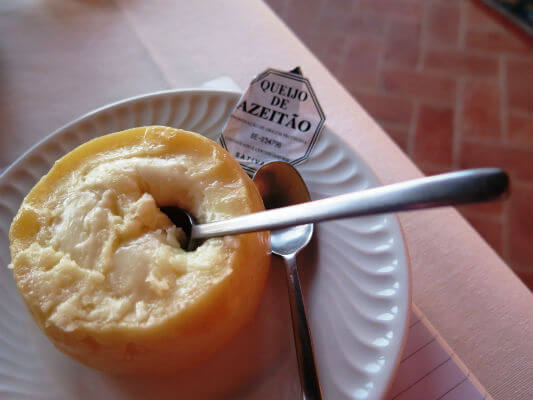
Also from the hills a perfect match for Moscatel de Setúbal – Azeitão sheeps milk cheese – Photo by Sarah Ahmed | All Rights Reserved
Adega de Pegões Moscatel de Setúbal 2012 – made from 100% Moscatel grown on sandy soils and aged in old French and American oak barrels for around 3 years. This is a lighter easy-going style with lifted buttermint, barley sugar, soft, round peachy fruit and caramelised oranges. Good perfume and freshness. 17.5%
Casa Ermelinda Freitas Moscatel de Setúbal 2010 – like the Pegões Moscatel this is from sandy soils, but it’s a good deal more complex. It’s aged for at least two years, normally four to five years in used oak barrels in a warehouse with no temperature control. And I suspect that this is what makes the difference, because it is more concentrated and complex on nose and palate, with delicious nutty rancio notes and a touch of malty oak to its caramelised orange palate; pithier maramalade notes (together with the nuttiness) balance the sweetness. Though generous, there’s good freshness to balance. Let’s just say this was particularly popular at the airport! 17.5%
José Maria da Fonseca Alambre Moscatel de Setúbal 2010 – this great value entry level Moscatel de Setúbal topped off most evenings during my holiday in the Costa Vicentina a couple of years ago. For approachability, the fruit is sourced from a sunny south-facing site and sandy as well as clay/limestone soils. Unlike some entry level wines, it was aged in old casks, which gives a delicious nutty edge to its toothsome caramelised orange palate; nice balance and length. 127g/l residual sugar; 17.5% abv.
José Maria da Fonseca Colecção Privada Moscatel de Setúbal 2004 – this wine is the direct outcome of brandy spirit trials. Winemaker Domingos Soares Franco discovered he liked using Armagnac best and Colecção Privada has lovely drive (good acidity) and persistence to its ripe, sweet citrus and rounder peach fruit. With lovely integration of spirit the finish goes on and on, revealing lightly toasted almonds, caramel, nougat and a touch of lifted (menthol) buttermint. The grapes are sourced only from clay and limestone soils. 106g/l residual sugar; 17.5% abv
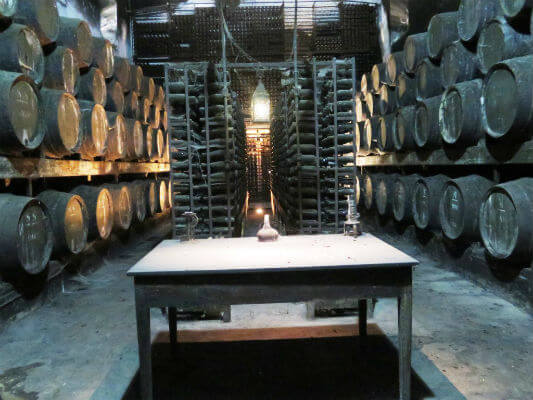
Stored under lock and key at Adega dos Teares Velhos José Maria da Fonseca’s oldest Moscatels – Photo by Sarah Ahmed | All Rights Reserved
José Maria da Fonseca 20 Year Old Moscatel de Setúbal – Portugal’s oldest wine producer has a massive trump card when it comes to making concentrated and complex Moscatel de Setúbal – many back vintages of Moscatel. They are stored in the atmospheric Adega dos Teares Velhos where the oldest wines, more than 100 years old, are under lock and key! António Soares Franco tells us that the youngest wines in this 20 Year Old non-vintage blend are 21-22 yrs old, while the oldest is 60 years old. He reckons it is a blend of “perhaps 13-14 different vintages.” It shows on the long, persistent, very complex, concentrated palate which reveals sweet candied orange peel, pithier, spicier marmalade notes and a bitter (balancing) hint of marmalade which has just caught in the pan. Very refined, with a lively, grapefruity cut of balancing acidity to the finish. 182g/l of residual sugar; 18.4% abv
José Maria da Fonseca Roxo 20 Year Old Moscatel de Setúbal – made from the much rarer pink-tinted Moscatel Roxo this is a significantly deeper hue than its predecessor and, despite having quite a bit more residual sugar, seems fresher, drier (well less toothsome) and lighter on its feet. Sweet, sharp but exotic flavours of mandarin, pink grapefruit and peach tea mingle in the mouth; great line and length. My pick of the JMF four (though I should declare that I’m a huge Roxo fan). 217.8g/l residual sugar; 18% abv.
SIVIPA Moscatel de Setúbal 1996 – from clay/limestone soils, this wine was aged for around 10 years in old French oak barrels. It is a complex, concentrated wine, just a touch spirity on the finish but mellifluous going through, with syrupy, peachy fruit, more concentrated dried apricot, toasted almonds and caramel. 180g/l residual sugar; 17% abv
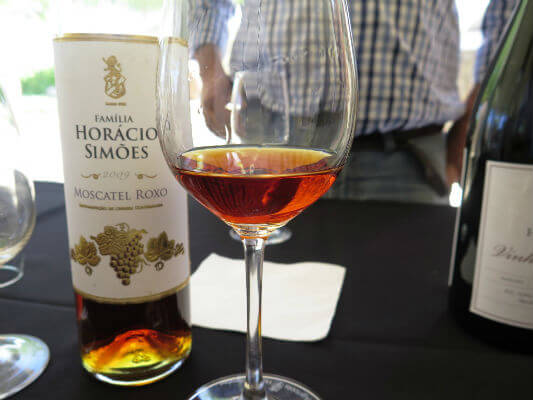
Horácio Simões Roxo Moscatel de Setúbal 2009
Casa Agrícola Horácio Simões Roxo Moscatel de Setúbal 2009 – I’m a big fan of Horácio Simões, a boutique third generation family producer. This long lingering Roxo shows why. Silkily textured with richly concentrated caramelised oranges and peach tea, it shows a hint of malty wood and delicious creamy praline notes to the finish (it is aged in seasoned French oak barriques). Terrific generosity and mouthfeel with balance.
Bacalhôa Vinhos de Portugal Moscatel Roxo Superior 2002 – my panel at Decanter World Wine Awards awarded this gorgeous Roxo a Gold Medal and Regional Trophy. I’d have awarded it the regional trophy all over again in this line up! Grapes are sourced from the cooler north clay/limestone slopes of the Serra da Arrábida. Still, aged for at least 10 years in small 200l French oak whisky barrels (which benefit from really clean pores) and in ship-like conditions with great thermal variation, it has surprising freshness, purity and lift. Referring to “the shocks of temperature, evaporation and concentration of acid and sugar and release of aromas connected with sugar,” Chief Winemaker Vasco Penha Garcia observes “it’s incredible when you age wines in these conditions that they get fresher, more floral.” Sure enough, Bacalhôa Roxo Superior 2002 has great intensity, lift and layer with rose water, buttermint and peach tea aromatics which follow through in the mouth together with a lovely purity of caramelised oranges, juicy mandarin, pink grapefruit peel and delicately toasted almonds and richer marzipan notes. Though luscious, it’s very persistent (good acid drive) and fine, the finish controlled, very balanced. 190.2g/l residual sugar; 19%.




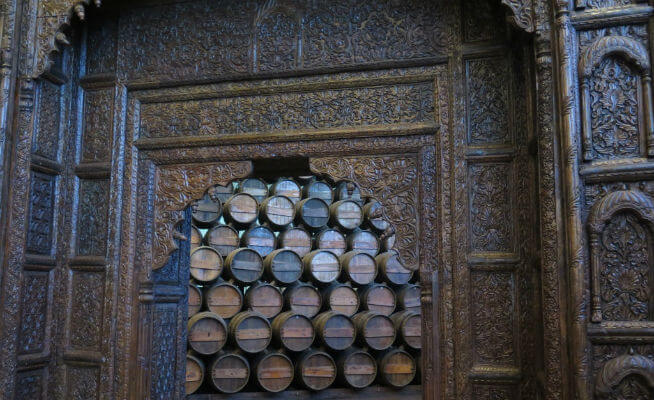
Leave a Reply